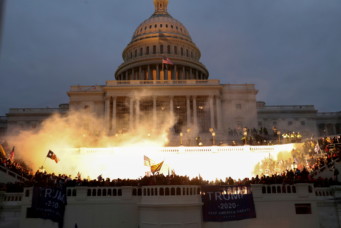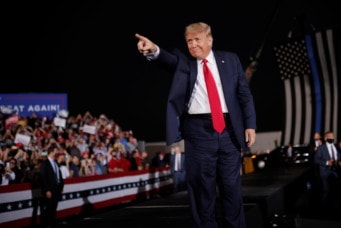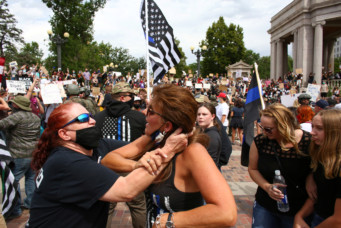The Normalization of Antidemocratic Extremism in the United States
To dissect the January 6 assault on the U.S. Capitol requires an understanding of the language of American political violence.

Joe Biden began his presidency on the steps of a heavily guarded Capitol, encircled by miles of austere barbed wire. There, he delivered an appeal to end America’s “uncivil war” to a public still reeling from the events of January 6, when a violent mob inspired by outgoing President Donald Trump descended on the U.S. Capitol, leading to five deaths.
In the wake of the attack, observers took to debating the appropriate language to describe the political significance of what happened. Was it a coup attempt, or wasn’t it? A putsch? An uprising?
Much of this early debate centered on what makes a coup a coup, and distinct from, say, a violent riot. Coups d’état – the term conjures the image of a military leading the violent overthrow of government. We picture, perhaps, the Chilean coup of September 1973, when military forces under General Augusto Pinochet ousted the elected President Salvador Allende. Or, perhaps, we picture the power grab in Myanmar, in February of this year, that led to sweeping detentions of top civilian leaders. Surely, we ask, the United States was nowhere close to this fate?
To some, this may seem like an obscure intellectual exercise. But it raises a broader issue: there are high normative and political stakes to how we portray, and talk about, political violence.
More than a quarter of post-World War II breakdowns of democracy around the world have been through “self-coups” that do not involve an armed rebellion, where a democratically elected government itself initiates a return to authoritarian practices. Importantly, the first warning signs of a self-defeating democracy are often the use of political rhetoric that fans the flames of extremism. From this viewpoint, although the Capitol attack was only loosely organized and the worst outcomes for democracy unrealized, its broader context should be a rude awakening for the United States that the probability of a self-coup is never zero.
The Larger Pattern around Political Violence
Indeed, January 6 is in many ways the consummation of an American, home-grown problem. The link between extremist antidemocratic views and violence is itself not new: such views animated Timothy McVeigh, whose 1995 bombing of a federal building in Oklahoma City killed 168; or the Unabomber Ted Kaczynski, whose mail-bomb attacks killed three and injured two dozen others.
What is significant about more recent acts of political violence is that high-ranking political leaders—notably the former President—are increasingly the sources of legitimating narratives around this violence.
After the 2017 white supremacist rally in Charlottesville, Virginia, descended into chaos, President Trump asserted that there were “very fine people on both sides,” seemingly legitimizing racists.
On these Charlottesville demonstrators, some of whom were chanting racist and anti-Semitic slogans, Trump noted, “You had a lot of people in that group that were there to innocently protest” and expressed sympathy for their actions in defending their “heritage.”
On Kyle H. Rittenhouse, who attended a Trump rally, showed up at a demonstration in Kenosha wielding a military-style rifle, and was later charged with homicide after two protestors were fatally shot, Trump cast the 17-year-old’s actions as self-defense: “I guess he was in very big trouble. He probably would have been killed.”
And when Trump was pressed to condemn white supremacy at a debate last year, he instead instructed the Proud Boys, a group with a history of violence, to “stand back and stand by.” These words thrilled extremists online who viewed them as vindication.
This handful of examples illustrates a larger pattern in the United States of how political narratives have been used to portray, and even legitimate, acts of violence, beyond the immediate lead-up to January 6.
Political rhetoric around violence can be direct—a politician using explicit racial slurs or calling for particular groups or individuals to be locked up or shot. However, more often than not, the discourse around political violence is implicit. It draws on a moral vocabulary, rich in metaphor, that paints targeted groups as a disease threatening a healthy body politic, as animals, as enemies that threaten the “nation-ness” of a state.
Consider the poem, “The Snake,” that Trump appropriated and repeatedly used in his 2016 and 2020 campaigns as an allegory of the threats posed by immigrants and refugees. The poem describes the story of a snake who convinces a woman to take him into her house for shelter from the cold.
After the woman (the naïve character symbolizing the United States, in Trump’s interpretation) nurses the snake (the stand-in for immigrants and refugees) back to health on “honey and some milk,” the snake delivers a fatal bite. Trump’s recitation of the final lines—“‘Oh, shut up, silly woman!’ said the reptile with a grin. ‘You knew damn well I was a snake before you took me in’”—typically invites a raucous cheer from the crowd.
Violence-Legitimating Rhetoric
Moral and normative language is similarly deployed to elevate the behavior of those on the violent extreme-right as rightful protectors and gatekeepers of the nation. Throughout the day on January 6, Trump continued to falsely claim that the election was stolen, firing up some supporters to “take the country back.” Trump’s “law and order” pitch, too, is well-known.
This pattern goes back further. In August 2015, two Boston brothers assaulted a Mexican American homeless man and told police they were inspired by Trump to do something about how, “All of these illegals need to be deported.”
Trump responded to this 2015 assault by casting the brothers’ behavior as symptoms of brimming patriotism. “The people that are following me are very passionate. They love this country. They want this country to be great again,” he told reporters.
By April 30, 2020, when protesters stormed the state Capitol in Michigan to protest measures aimed at limiting the spread of the coronavirus, such moralizing language had become commonplace in political communication, even banal. In the leadup, Trump had used social media to call on people to “LIBERATE MICHIGAN” and other states, invoking the language of a righteous revolution.
To be sure, this is not simply about Trump the individual. Often, what is not said by a broader group of political elites is as consequential as what is. In the wake of the Capitol attack, several politicians from both sides of the aisle expressed shock at the apparent “latinamericanization” of the United States into a “banana republic”.
Beyond being a shallow and misguided comparison, such characterizations betrayed a deep-seated belief in American exceptionalism. The moral language of “this is not who we are” was shared by a cross-cutting group in the United States, from hardcore liberals to centrist legislators, to veterans who attended the rally on January 6 but did not participate in the mob.
Yet, this is beside the point. Superficial gestures to an exotic “banana republic” or “Beer Hall Putsch” take the attention of an already news-weary public away from domestic warning signs and risk culturally priming political actors to view events like those of January 6 as an anomaly, a one-off random error.
The failure to talk about, and critically analyze, political violence for what it is sends a signal to the public that such acts are either idiosyncrasies – “this is not who we are” – and therefore do not require rigorous problem-solving, or, worse, that such acts are socially tolerated.
The fact that extremists often parrot elites’ language of morality politics speaks to this point. According to a 2019 report, counties that hosted a 2016 rally with Trump headlining experienced a 226 percent increase in hate crimes. This suggests that the use of violence-legitimating rhetoric is simultaneously an indicator and purveyor of the state of polarization and political violence in the United States.
Pushing back against the Language of Violence
Then, what can be done?
Here is what we know: individuals’ beliefs—in particular, intergroup or political prejudices—are tough to change, even as people take cues from political elites quite readily. That is, violent political narratives do not necessarily persuade otherwise peaceful people to adopt violent views. But these narratives may well embolden a small subset of the population to feel that their private extremist, racist, or antidemocratic beliefs are more socially acceptable to express publicly—and, furthermore, that it is not only acceptable to act on them, but a duty to do so.
Combating misinformation in portrayals of political violence is a crucial step, but not a cure-all. It remains important to explicitly call out political messaging that seems to romanticize and legitimate violent behavior. This is the kind of behavior which equates violent claims to morally justifiable ones, or else brushes them away as problems imported from proverbial “banana republics.”
Similarly, when politicians and pundits marshal language with rhetorical flair like “civil war” or the United States’ “next insurgency” to describe the country’s current situation, it threatens to play into or even vindicate fringe extremist narratives about “the deep state,” instead of dismantling them.
Countering antidemocratic extremism in a meaningful way will therefore require recognizing and calling out violence-legitimating rhetoric, but also avoiding this kind of casual rhetoric in the first place.
This will require equipping people with the ability to themselves recognize problematic narratives in political and public discourse. Online sources are a key conduit through which ordinary citizens encounter narratives, violent or otherwise. Thus, investments in programs that improve digital literacy with a focus on clear-eyed, critical consumption of information are crucial. But this activity needs to happen online and off. The government could support such programs through schools as well as credible civil society organizations in local communities. Ideally, such programs would build on existing federal or local initiatives on digital literacy.
This kind of educational approach would be resource-intensive and its payoffs may not be immediate. But it would fill a critical gap. Many governments, including that of the United States, often take a reactive approach by pressuring private firms, especially social media companies, to flag or remove user-generated content that could incite violent behavior. Yet, narratives live everywhere—not only on social media but also in blogs and internet forums. The sheer volume of content online suggests that the reactive approach is limited in its efficacy. The educational approach would build on where the reactive approach falls short. It is, in essence, a “teach a man to fish” method.
In the short- and medium-term, the framing of the January 6 attack will determine how accountability is to be achieved. But the way the violence on January 6 is remembered, recorded, and reflected in public discourse will likely have deep consequences for generating—or mitigating—political violence in the long-term as well.
Words matter. This is arguably one of the most important and enduring lessons from the Trump administration’s four years. Words incite and mobilize, enrage, and inspire. The language we use to name and talk about the violence on January 6 will shape this trajectory of the United States for years to come.





